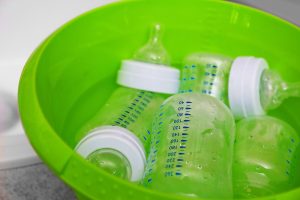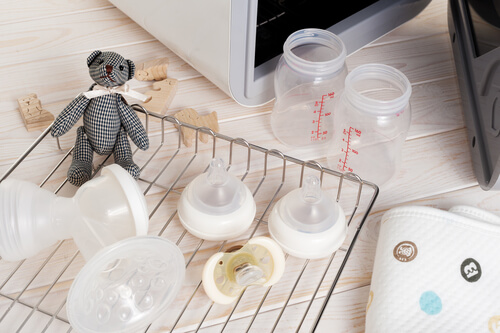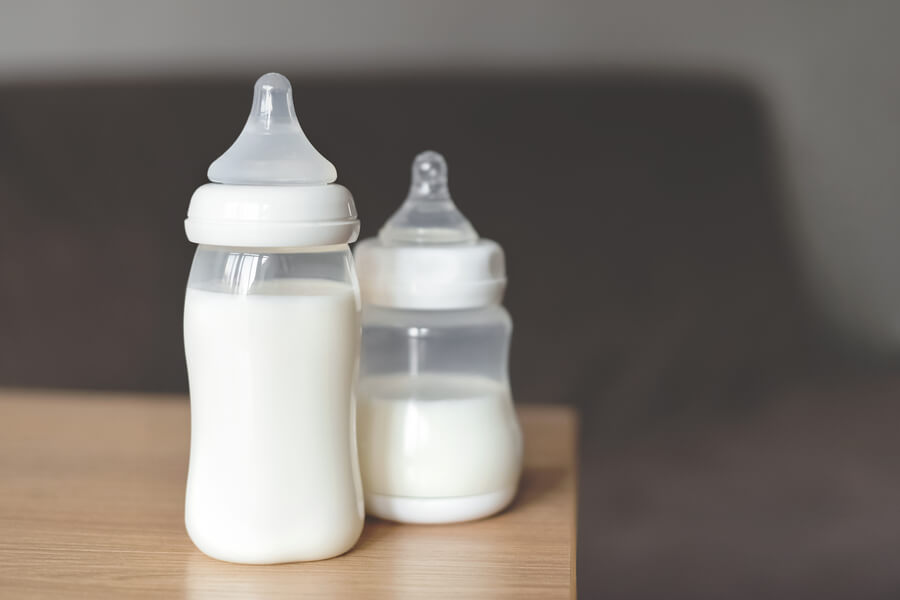Tips to Sterilizing Baby Bottles

The arrival of a newborn brings enormous joy to parents, yet it also comes with several responsibilities and precautions. One of the most important aspects is feeding, which includes sterilizing baby bottles and pacifiers.
The World Health Organization emphasizes the importance of breastfeeding during the first months of a baby’s life. However, some mothers prefer not to breastfeed or can’t due to certain factors. At this point, mothers will use formula, which involves using bottles.
Is Sterilizing Baby Bottles Necessary?
The answer is yes, it’s necessary to sterilize baby bottles. When babies are born, they don’t have a fully developed immune system.
This means they don’t have the necessary defenses to prevent infections, vomiting or diarrhea. That’s why bottle sterilizing is very important.
There are many ways to sterilize used bottles and pacifiers. All are effective and vary according to each individual’s needs and circumstances.
Before handling these items, it’s extremely important to wash your hands with soap and water. This way, you can prevent transmitting any germs.
Types of Baby Bottle Sterilizers
Here are the most common ways to sterilize these instruments:
1. Sterilization of Baby Bottles with Boiling Water
This is one of the most economical processes and is always available to everyone. You should boil water in a container and put in the bottles, pacifiers, nipples, etc. Although it’s the most economical solution, it’s not the fastest.
With these traditional systems, the elements should remain in the boiling water for about 20 minutes. Once the bottles are sterilized, they must be used immediately. If not, the sterilization effect is lost.

2. Electric Steam Sterilizer
There is a huge variety in the market of steam bottle sterilizers. You can find them with different capacities, usually from four to six baby bottles. This is very useful, since they disinfect several elements at the same time.
The electric steam sterilizer is very easy to use. Just place the bottles inside the device and click the start button. Once the sterilization is finished, they can be stored in the same container where they were sterilized.
3. Microwave Bottle Sterilizer
This type of device is also practical and quite popular among bottle sterilization options. To use it, you have to wash the bottles, put them in the sterilizer, add the water and then take them to the microwave.
These products are light and economical. They vary according to their capacity, which can be from two to six baby bottles. In addition, they sterilize pacifiers and other baby items. They are affordable and you only need a microwave to use them.
“Before handling these items, it is extremely important to wash your hands with soap and water. This way, you can prevent transmitting any germs.”
4. Chemical Bottle Sterilization
Known as cold sterilizers, you dissolve a tablet in cold water and it sterilizes the water. The great disadvantage of this method is that it takes a long time. The process takes between 30 and 60 minutes.
However, they’re easy to use and highly recommended for families who travel often. They don’t require electricity or present risks since the process is carried out with cold water.
5. Self-Sterilizing Bottles
This type of product is very practical when you don’t have the usual sterilization devices on hand. You just put water in it, then put it in the microwave and the bottle will be sterilized. They aren’t expensive and are very helpful in tight situations.

Tips to Clean and Preserve the Bottle Sterilizer
One daily tip to keep in mind to conserve the sterilizer is to make sure there is no water left in the bottom. Before putting the bottles and pacifiers in a sterilizer, they should be dried well, because bacteria grow in humidity.
After using whatever device you choose, it’s important to wait for it to cool to remove the objects. It’s also essential to remove the water to keep it clean and dry, as well as disconnect it after use.
Once a week, it’s recommended to clean the inner grills and the lid of the sterilizer very thoroughly. It’s also useful to pass a cotton ball with alcohol on the outside of the sterilizer. Don’t forget the plastic part of the cable and the plug.
Finally, it’s a good idea to make a mixture of water and white vinegar monthly. What you should do is pour it in the sterilizer and turn it on. The vinegar works as a disinfectant, which helps clean the sterilizer thoroughly.
The arrival of a newborn brings enormous joy to parents, yet it also comes with several responsibilities and precautions. One of the most important aspects is feeding, which includes sterilizing baby bottles and pacifiers.
The World Health Organization emphasizes the importance of breastfeeding during the first months of a baby’s life. However, some mothers prefer not to breastfeed or can’t due to certain factors. At this point, mothers will use formula, which involves using bottles.
Is Sterilizing Baby Bottles Necessary?
The answer is yes, it’s necessary to sterilize baby bottles. When babies are born, they don’t have a fully developed immune system.
This means they don’t have the necessary defenses to prevent infections, vomiting or diarrhea. That’s why bottle sterilizing is very important.
There are many ways to sterilize used bottles and pacifiers. All are effective and vary according to each individual’s needs and circumstances.
Before handling these items, it’s extremely important to wash your hands with soap and water. This way, you can prevent transmitting any germs.
Types of Baby Bottle Sterilizers
Here are the most common ways to sterilize these instruments:
1. Sterilization of Baby Bottles with Boiling Water
This is one of the most economical processes and is always available to everyone. You should boil water in a container and put in the bottles, pacifiers, nipples, etc. Although it’s the most economical solution, it’s not the fastest.
With these traditional systems, the elements should remain in the boiling water for about 20 minutes. Once the bottles are sterilized, they must be used immediately. If not, the sterilization effect is lost.

2. Electric Steam Sterilizer
There is a huge variety in the market of steam bottle sterilizers. You can find them with different capacities, usually from four to six baby bottles. This is very useful, since they disinfect several elements at the same time.
The electric steam sterilizer is very easy to use. Just place the bottles inside the device and click the start button. Once the sterilization is finished, they can be stored in the same container where they were sterilized.
3. Microwave Bottle Sterilizer
This type of device is also practical and quite popular among bottle sterilization options. To use it, you have to wash the bottles, put them in the sterilizer, add the water and then take them to the microwave.
These products are light and economical. They vary according to their capacity, which can be from two to six baby bottles. In addition, they sterilize pacifiers and other baby items. They are affordable and you only need a microwave to use them.
“Before handling these items, it is extremely important to wash your hands with soap and water. This way, you can prevent transmitting any germs.”
4. Chemical Bottle Sterilization
Known as cold sterilizers, you dissolve a tablet in cold water and it sterilizes the water. The great disadvantage of this method is that it takes a long time. The process takes between 30 and 60 minutes.
However, they’re easy to use and highly recommended for families who travel often. They don’t require electricity or present risks since the process is carried out with cold water.
5. Self-Sterilizing Bottles
This type of product is very practical when you don’t have the usual sterilization devices on hand. You just put water in it, then put it in the microwave and the bottle will be sterilized. They aren’t expensive and are very helpful in tight situations.

Tips to Clean and Preserve the Bottle Sterilizer
One daily tip to keep in mind to conserve the sterilizer is to make sure there is no water left in the bottom. Before putting the bottles and pacifiers in a sterilizer, they should be dried well, because bacteria grow in humidity.
After using whatever device you choose, it’s important to wait for it to cool to remove the objects. It’s also essential to remove the water to keep it clean and dry, as well as disconnect it after use.
Once a week, it’s recommended to clean the inner grills and the lid of the sterilizer very thoroughly. It’s also useful to pass a cotton ball with alcohol on the outside of the sterilizer. Don’t forget the plastic part of the cable and the plug.
Finally, it’s a good idea to make a mixture of water and white vinegar monthly. What you should do is pour it in the sterilizer and turn it on. The vinegar works as a disinfectant, which helps clean the sterilizer thoroughly.
All cited sources were thoroughly reviewed by our team to ensure their quality, reliability, currency, and validity. The bibliography of this article was considered reliable and of academic or scientific accuracy.
- Rutala WA., Weber DJ., Disinfection, sterilization, and antisepsis: an overview. Am J Infect Control, 2016. 44: 1-6.
- Zulauf KE., Green AB., Nguyen BA., Jagdish T., et al., Microwave generated steam decontamination of N95 respirators utilizing universally accessible materials. mBio, 2020.
This text is provided for informational purposes only and does not replace consultation with a professional. If in doubt, consult your specialist.








